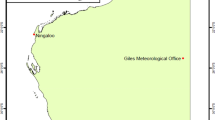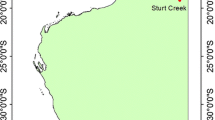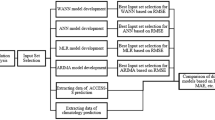Abstract
This paper presents the comparison of the performances between the linear and non-linear modelling techniques in re-generating the patterns of long-term seasonal rainfall in Western Australia. To construct the linear and non-linear models, commonly adopted multiple linear regression (MLR) and artificial neural network (ANN) modelling approaches were applied. Lagged (past) values of the oceanic climate drivers, El Niño Southern Oscillation (ENSO) and Indian Ocean Dipole (IOD) were considered to be the prospective forecasters of seasonal rainfall. The MLR models which were statistically significant and not susceptible to multicollinearity problems were considered as the potential models. The Lavenberg–Marquardt algorithm with Multilayer Perceptron training rule was adopted to construct the non-linear ANN models. The capability of both the MLR and ANN models were evaluated through commonly used statistical parameters. Since rainfall vary not only temporally but also spatially, the analysis were performed on regional scale. The methods were applied to three Western Australian rainfall stations. As expected, in estimating Western Australian spring rainfalls, non-linear ANN models performed much better compared to MLR models in regards to Pearson correlation as well as statistical errors.




Similar content being viewed by others
References
Abbot J, Marohasy J (2012) Application of Artificial Neural Networks to rainfall forecasting in Queensland Australia. Adv Atmos Sci 29(4):717–730
Abbot J, Marohasy J (2014) Input selection and optimisation for monthly rainfall forecasting in Queensland, Australia, using artificial neural networks. Atmos Res 138:166–178
Anwar MR, Rodriguez D, Liu DL, Power S, O’leary GJ (2008) Quality and potential utility of ENSO-based forecasts of spring rainfall and wheat yield in south-eastern Australia. Aust J Agric Res 59:112–126
Ashok K, Guan Z, Yamagata T (2003) Influence of the Indian Ocean Dipole on the Australian winter rainfall. Geophys Res Lett 30:1821
Cancelliere A, Giuliano G, Ancarani A, Rossi G (2002) A neural networks approach for deriving irrigation reservoir operating rules. Water Resour Manage 16:71–88
Chiang Y, Chang L, Tsai M, Wang Y, Chang F (2010) Dynamic neural networks for real-time water level predictions of sewerage systems-covering gauged and ungauged sites. Hydrol Earth Syst Sci 14:1309–1319
Chiew F, Piechota TC, Dracup J, McMahon T (1998) El Nino/Southern oscillation and Australian rainfall, streamflow and drought: links and potential for forecasting. J Hydrol 204:138–149
Dawson CW, Wilby RL (2001) Hydrological modelling using artificial neural networks. Prog Phys Geogr 25:80–108
de Vos and Rientjes (2008) Multiobjective training of artificial neural networks for rainfall-runoff modelling. Water Resour Res 44
Demuth H, Beale B (2004) Neural network toolbox user guide. The Math Works Inc, Natick
Dibike YB, Solomatine DP (2001) River flow forecasting using artificial neural networks. Phys Chem Earth Part B 26:1–7
Esha RI, Imteaz AM (2017) Seasonal streamflow prediction using large scale climate drivers for NSW region. In: Proceeding of the 22nd international congress on modelling and simulation, Hobart, Tasmania Australia, pp 1593–1599.
Field AP (2009) Discovering statistics using SPSS. SAGE publications Ltd, New York.
Ghiassi M, Zimbra DK, Saidane H (2008) Urban water demand forecasting with a dynamic artificial neural network model. J Water Resour Plan Manage 134:138–146
He X, Guan H, Zhang X, Simmons CT (2014) A wavelet-based multiple linear regression model for forecasting monthly rainfall. Int J Climatol 34:1898–1912
Hendon HH, Thompson DWJ, Wheeler MC (2007) Australian rainfall and surface temperature variations associated with the southern annular mode. J Clim 20:2452–2467
Hossain I, Rasel HM, Imteaz MA, Moniruzzaman M (2015) Statistical correlations between rainfall and climate indices in Western Australia. In: Proceeding of the 21st international congress on modelling and simulation, Gold Coast, Australia, pp 1991–1997
Hossain, I, Rasel, HM, Imteaz, MA, Mekanik F (2018) Long-term seasonal rainfall forecasting: efficiency of linear modelling technique. Environ Earth Sci 77:280 (1–10)
Hsu K, Gupta HV, Sorooshian S (1995) Artificial neural network modeling of the rainfall-runoff process. Water Resour Res 31:2517–2530
Hudson D, Alves O, Hendon HH, Wang G (2011) The impact of atmospheric initialisation on seasonal prediction of tropical Pacific SST. Clim Dyn 36:1155–1171
Ihara C, Kushnir Y, Cane MA, De La Pena VH (2007) Indian summer monsoon rainfall and its link with ENSO and Indian Ocean climate indices. Int J Climatol 27:179–187
Islam F, Imteaz MA, Rasel HM (2017) Analysing the effect of lagged climate indices on rainfall predictability for Western Australian North Coast Region. In: Proceeding of the 22nd international congress on modelling and simulation, Hobart, Tasmania Australia, pp 1600–1606
Karthikeyan L, Kumar DN, Graillot D, Gaur S (2013) Prediction of ground water levels in the uplands of a tropical coastal riparian wetland using artificial neural networks. Water Resour Manage 27:871–883
Khashei M, Hejazi SR, Bijari M (2008) A new hybrid artificial neural networks and fuzzy regression model for time series forecasting. Fuzzy Sets Syst 159:769–786
Kirono DGC, Chiew FHS, Kent DM (2010) Identification of best predictors for forecasting seasonal rainfall and runoff in Australia. Hydrol Process 24(10):1237–1247
Latt ZZ, Wittenberg H (2014) Improving flood forecasting in a developing country: a comparative study of stepwise multiple linear regression and artificial neural network. Water Resour Manage 28:2109–2128
Lin FJ (2008) Solving multicollinearity in the process of fitting regression model using the nested estimate procedure. Qual Quant 42(3):417–426
Maier HR, Dandy GC (2001) Neural network based modelling of environmental variables: a systematic approach. Math Comput Model 33:669–682
Maqsood I, Khan MR, Abraham A (2004) An ensemble of neural networks for weather forecasting. Neural Comput Appl 13:112–122
Mekanik F, Imteaz MA, Gato-Trinidad S, Elmahdi A (2013) Multiple linear regression and artificial neural network for long-term rainfall forecasting using large scale climate modes. J Hydrol 503:11–21
Meneghini B, Simmonds I, Smith IN (2007) Association between Australian rainfall and the southern annular mode. Int J Climatol 27:109–121
Meyers G, McIntosh P, Pigot L, Pook M (2007) The years of El Niño, La Niña, and interactions with the tropical Indian Ocean. J Clim 20:2872–2880
Peel MC, McMahon TA, Finlayson BL, Watson TA (2001) Identification and explanation of continental differences in the variability of annual runoff. J Hydrol 250:224–240
Ramirez MCV, Velho HFC, Ferreira NJ (2005) Artificial neural network technique for rainfall forecasting applied to the Sao Paulo region. J Hydrol 301:146–162
Rasel, HM, Imteaz, MA, Mekanik F (2015) Evaluating the effects of lagged ENSO and SAM as potential predictors for long-term rainfall forecasting. In: Proceedings of the international conference on water resources and environment (WRE 2015), Beijing, China, 25–28 July, Taylor and Francis Group, London/Miklas Scholz (ed), pp 125–129
Risbey JS, Pook MJ, McIntosh PC, Wheeler MC, Hendon HH (2009) 2009, On the remote drivers of rainfall variability in Australia. Mon Weather Rev 137(10):3233–3253
Tarboton DG (2003) Rainfall-runoff processes. Utah State University, Logan
Tokar AS, Markus M (2000) Precipitation-runoff modelling using artificial neural networks and conceptual models. J Hydrol Eng 5:156–161
Toth E, Brath A, Montanari A (2000) Comparison of short-term rainfall prediction models for real-time flood forecasting. J Hydrol 239:132–147
Ummenhofer CC, Gupta A, Pook MJ, England MH (2008) Anomalous rainfall over southwest Western Australia forced by Indian Ocean Sea surface temperatures. J Clim 21(19):5113–5134
Verdon DC, Wyatt AM, Kiem AS, Franks SW (2004) Multidecadal variability of rainfall and streamflow: Eastern Australia. Water Resour Res 40(10):W10201
Vitart F (2004) Monthly forecasting at ECMWF. Mon Weather Rev 132:2761–2779
Wang G, Hendon HH (2007) Sensitivity of Australian rainfall to inter—El Niño variations. J Clim 20:4211–4226
Willmott CJ (1984) On the validation of models. Phys Geogr 2:184–194
Zhang G, Patuwo BE, Hu MY (1998) Forecasting with artificial neural networks: the state of the art. Int J Forecast 14:35–62
Author information
Authors and Affiliations
Corresponding author
Additional information
Responsible Editor: E.-K. Jin.
Publisher's Note
Springer Nature remains neutral with regard to jurisdictional claims in published maps and institutional affiliations.
Rights and permissions
About this article
Cite this article
Hossain, I., Rasel, H.M., Imteaz, M.A. et al. Long-term seasonal rainfall forecasting using linear and non-linear modelling approaches: a case study for Western Australia. Meteorol Atmos Phys 132, 131–141 (2020). https://doi.org/10.1007/s00703-019-00679-4
Received:
Accepted:
Published:
Issue Date:
DOI: https://doi.org/10.1007/s00703-019-00679-4




